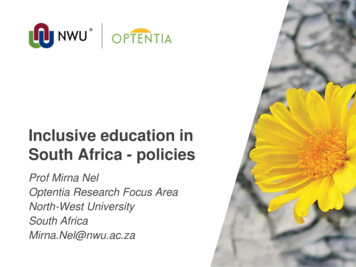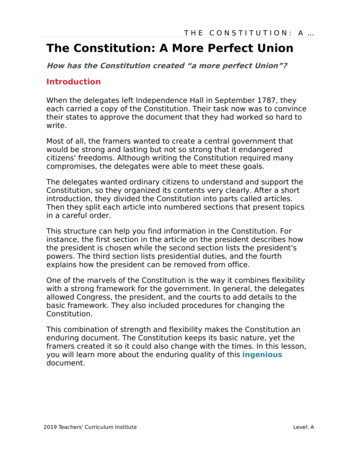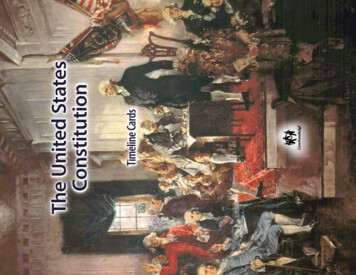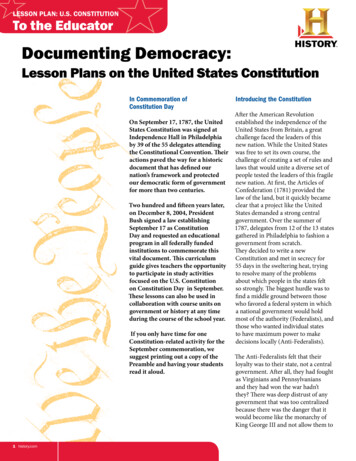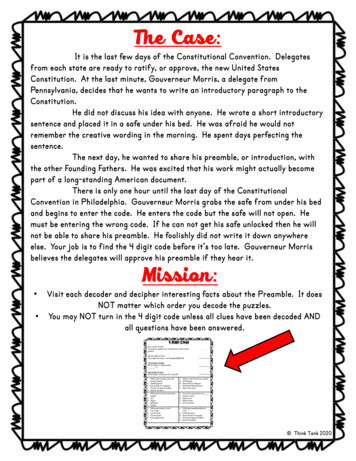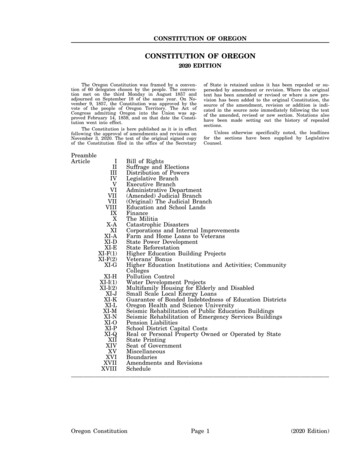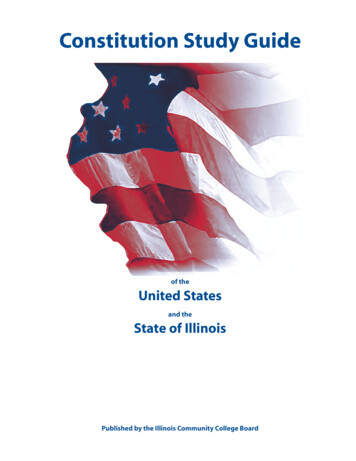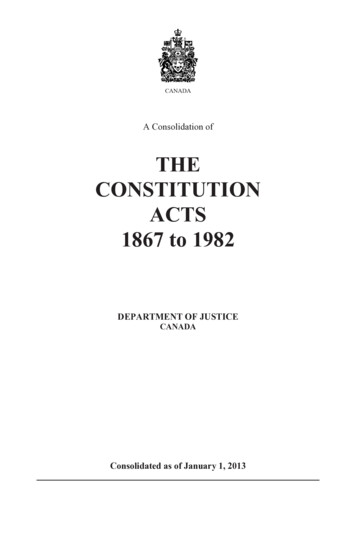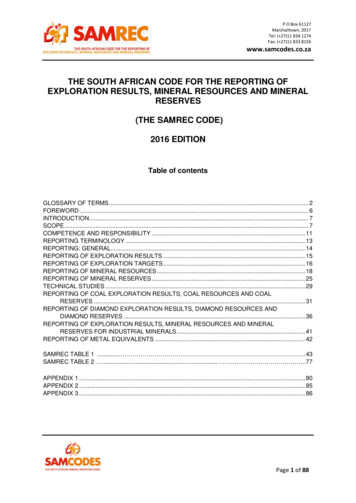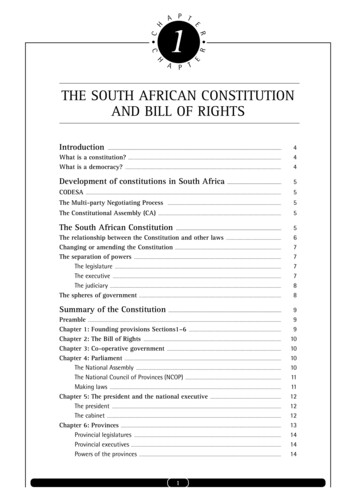
Transcription
PRECHARC1EHA P TTTHE SOUTH AFRICAN CONSTITUTIONAND BILL OF RIGHTSIntroductionWhat is a constitution? .What is a democracy? .444Development of constitutions in South Africa.5.5CODESA.5.5The Multi-party Negotiating ProcessThe Constitutional Assembly (CA)The South African Constitution.The relationship between the Constitution and other laws .Changing or amending the Constitution .The separation of powers .The legislature .The executive .The judiciary .The spheres of government .Summary of the Constitution.Preamble .Chapter 1: Founding provisions Sections1–6 .Chapter 2: The Bill of Rights .Chapter 3: Co-operative government .Chapter 4: Parliament .The National Assembly .The National Council of Provinces (NCOP) .Making laws .Chapter 5: The president and the national executive .The president .The cabinet .Chapter 6: Provinces .Provincial legislatures .Provincial executives .Powers of the provinces .15677778899910101010111112121213141414
Chapter 7: Local government.Who can vote in local government elections?Powers of local government.14.14.14.15Chapter 8: Courts and administration of justiceThe Constitutional CourtThe Supreme Court of AppealHigh Courts14.16.16Magistrate’s Courts.How judges are chosen.16.17.17Chapter 10: Public administration.17.17Chapter 12: Traditional authoritiesChapter 13: FinanceThe National Revenue Fund.The Financial and Fiscal CommissionHow taxes are budgeted17.18.18.18.18.18What are human rights?Indivisibility of rights.19.19Rights and responsibilitiesConflicts in rights17.Chapter 14: General provisionsHuman rights16.Chapter 9: State institutions that support constitutional democracyChapter 11: Security services16International documents on human rights.Creating a human rights culture in South Africa.Summary of the South African Bill of RightsSection 7: Introduction21.21.21.21.22Section 8: Application of the Bill of RightsSection 9: Right to equality.23.23Section 10: Right to human dignitySection 11: Right to life20Section 12: Freedom and security of the person.24.24Section 13: Slavery, servitude and forced labourSection 14: Right to privacy24.25.25Section 15: Freedom of religion, belief and opinionSection 16: Freedom of speech and expression.25.25.25Section 20: Citizenship .Section 21: Freedom of movement and residence .2626Section 22: Freedom of trade, occupation and profession26Section 17: Freedom of assembly, demonstration, picket and petitionSection 18: Freedom of associationSection 19: Political rights2.
.26.26.26Section 23: Labour relationsSection 24: EnvironmentSection 25: PropertySection 26: Right of access to housing.28.28.29Section 27: Right of access to health care, food, water and social securitySection 28: Children’s rightsSection 29: EducationSection 30: Language and culture.Section 32: Access to information29.29.29.32Section 33: Just administrative actionSection 34: Access to courts.32.33.33.34Section 35: Arrested, detained and accused personsSection 36: Limitations on rightsSection 37: States of emergencySection 38: Enforcing rights29.Section 31: Cultural, religious and linguistic communities.34.34.34Section 39: Interpreting the Bill of RightsProtecting human rightsThe Public Protector27How is the Public Protector appointed?.35.35.35The functions of the Public ProtectorWhat can the Public Protector do?Making a complaint to the Public Protector.36.36South African Human Rights Commission (SAHRC)Making a complaint to the SAHRC.36.36Commission on Gender Equality (CGE)What can the CGE do?35Making a complaint to the CGE.37.37Commission for the Promotion and Protection ofthe Rights of Cultural, Religious and Linguistic Communities(Cultural Commission) .37Independent Electoral Commission (IEC)37The Auditor General.37.37Independent Communications Authority of South Africa (ICASA)Land Claims Commission (LCC)Problems.38.381: Taking a case to the South African Human Rights Commission2: Making a complaint to the Public Protector.39.403: Taking a case to the Commission on Gender EqualityChecklist.40RESOURCES .677Reporting human rights complaints3
IntroductionIn 1994, after decades of living under an apartheid government, the firstdemocratic election was held in South Africa. For the first time South Africa couldcall itself a democracy because everyone who was a citizen of South Africa couldvote in the elections. The Constitutional Assembly was constituted with the task ofdrawing up a Constitution to represent the interests and needs of all the people ofSouth Africa. Included in the Constitution was a Bill of Rights which gives peoplerights and responsibilities.What is a constitution?A constitution of a country sets out: The social values that the country believes in The structures of government What powers and authority a government and government bodies have The rights of citizens The relationship between government and citizens Aspects of the relationships between citizensA constitution is the highest law in the land and must be respected by allgovernment bodies. It is higher than parliament and it can override any law thatparliament makes if the law goes against the constitution. No law can go againstthe Constitution, whether it is a Customary law or a law that parliament makes.The South African Constitution of 1996 is a document that consists of 14 chapters.It says how the government should rule the country and it includes a Bill of Rights.What is a democracy?Democracy means that everyone has a say about how the country is run. In ademocracy, the government is put into power by its citizens. The adult citizens ofa democracy elect their government. One way they do this is by choosing peopleto represent them in a parliament. In a multi-party system, the party that gets themajority votes governs the country.CHARACTERISTICS THAT IDENTIFY A DEMOCRACYCitizens can participate in governmenttheir own work and join labour unions.It is everyone's right and duty to participate in government.Controlling abuse of powerAll people are equal before the lawThere must be ways to prevent government officials fromabusing their power. The courts are independent from thegovernment, and there are other bodies that have the powerto act against corrupt government officials.There is no legal discrimination based on race, religion,gender or other reason. Groups and individuals have a rightto their own cultures, languages, beliefs and so on.Political toleranceHuman rightsVarious opinions, beliefs, cultures, religions and so on needto be tolerated. So, while the majority of the people rule in ademocracy, the rights of the minority must still be protected.Democracies aim to respect and protect the human rightsof all and often use a Bill of Rights to do so. .Multi-party systemAccountabilityA multi-party system means that more than one politicalparty can participate in elections, so that people can choosewho they want to represent them in government.Officials that are elected and appointed in governmentare accountable to the people for actions and decisions.The rule of lawTransparencyNo one is above the law, including the president. This meansthat the law must treat everyone in an equal and fair way.In a democracy, people and the media (newspapers, tv, radio)can get information about what government decisions arebeing made, by whom and for what reason.The separation of powers betweendifferent arms of governmentRegular, free and fair electionsThe Legislature (parliament) made up of people’s representatives, make the laws and policies. The Executive (cabinet)implement and oversee the public service. The Judiciary actas independent referees to interpret the law when there aredisputes or conflicts or someone breaks the law.Citizens choose their own representatives for government.They elect these officials in a free and fair way, without corruption and votes are secret. Elections are held regularly.Economic freedomPeople can own property and businesses and they can choose(See page 62 Public participation)4
Development of constitutions in South AfricaBetween 1910 and 1994 there have been four Constitutions in South Africa: In 1910 Britain decided to withdraw from the government of South Africa andhanded the country over to the white residents of the country who were theBritish settlers and Boers. The first Constitution for the Union of South Africawas adopted in 1910. This gave rights to the white minority but took away theright to vote of the majority of South Africans. In 1960 the white government held a referendum to decide whether South Africawould become a Republic. On 31 May 1961 South Africa was declared a Republicand the government adopted the second Constitution. This also took away therights of black people. In 1983 the government passed the third Constitution. This Constitution createdthe tricameral parliament, which meant there was a separate parliament for theWhite, Coloured and Indian groups. This Constitution excluded black people andautomatically made them citizens of the homeland where they were born. Theyhad no rights outside these homelands. In 1994, twenty-six parties negotiated and adopted an interim Constitution thatgave the vote to everyone. This Constitution lasted for two years. During thattime the elected government worked as the Constitutional Assembly and had todraw up a final Constitution. This finally became law on 18 December 1996.CODESAOn 2 February 1990, the National Party government unbanned political parties,released many political prisoners and detainees, and unbanned many people,including Nelson Mandela.On 20 and 21 December 1990 the first session of CODESA (Convention for aDemocratic South Africa) was held. There were 19 political groups at this event.All parties agreed to support the Declaration of Intent, which said that they wouldbegin writing a new Constitution for South Africa.The Multi-party Negotiating ProcessIn March 1993 full negotiations were initiated under the name of the MPNP Multi-party Negotiating Process - instead of CODESA. Twenty-six parties tookpart in the MPNP to write and adopt an interim Constitution to say how thegovernment would govern after the elections on 27 April 1994. The MPNP drew upthe Interim Constitution which was to last for two years.The Constitutional Assembly (CA)After the elections in 1994 the new parliament - working as the ConstitutionalAssembly (CA) – wrote the final Constitution and on 8 May 1996, it was finallyadopted by the Constitutional Assembly. The final Constitution was passed byparliament and became law on 18 December 1996.The South African ConstitutionThe South African Constitution describes the social values of the country, andsets out the structures of government, what powers and authority a governmenthas, and what rights citizens have. The Founding Provisions of the Constitutionset out the principles and guarantees of democracy in South Africa.(See page 9 Founding Provisions)Because the Constitution is the highest law in the land, it stops each newgovernment from passing its own laws that contradict the Constitution. It is5
also much more difficult to change the Constitution than any other law, as itneeds a two thirds majority vote in parliament. The Constitution therefore protectsdemocracy in South Africa.A government should never have unlimited power. Even governments which havebeen democratically elected can abuse the power that they have been given. Thereare cases of governments who were elected in democratic elections, and who thenrefused to allow further elections and became permanent rulers. Other governmentsabuse their power by persecutin
In 1994, after decades of living under an apartheid government, the first democratic election was held in South Africa. For the first time South Africa could call itself a democracy because everyone who was a citizen of South Africa could vote in the elections. The Constitutional Assembly was constituted with the task of

